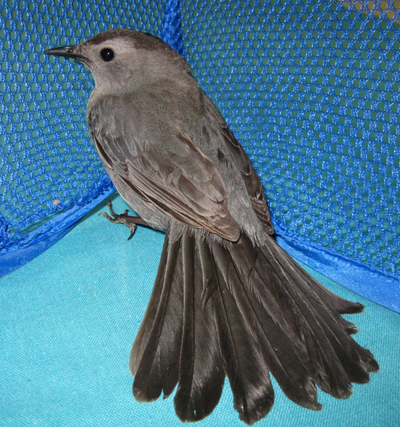
May 7, 2013
What do we know about gray catbird song?
Repertoire:
- Improvises and invents (Kroodsma et al. 1997)
- Syllables not in fixed sequences and seldom repeated consecutively (Thompson and Jane 1969 cited in Smith et al. 2020, Fletcher and Smith 1969 )
- Mimic
- Quiet song (Whittle 1923b)
Neighbors:
- Mew in chorus at sunrise and dusk (Smith et al. 2020)
- Do not seem to share songs (Kroodsma 1997)
Females:
- Rarely sing (Whittle 1923b, Harcus 1973 cited in Smith et al. 2020)
- Known to duet (Whittle 1923b)
How and when is song acquired?
- Since gray catbird song is largely created by improvising and invention, it is assumed that song is controlled by internal mechanisms (Kroodsma 1997).
- They mimic other birds.
How can we facilitate learning?
- House outside with singing adults of many species
- Expose to variety of songs to facilitate large repertoire
………………………………………………………
Resources:
Fletcher, L. E. and D. G. Smith. (1978). Some parameters of song important in conspecific recognition by Gray Catbirds. Auk 95:338-347.
Harcus, J. L. (1973). Song studies in the breeding biology of the Catbird, Dumetella carolinesis (Aves: Mimidae). Phd Thesis, Univ. of Toronto, Toronto.
Kroodsma, D. E., P. W. Houlihan, P. A. Fallon and J. A. Wells. (1997). Song development by grey catbirds. Animal Behaviour 54:457-464.
Smith, R. J., M. I. Hatch, D. A. Cimprich, and F. R. Moore (2020). Gray Catbird (Dumetella carolinensis), version 1.0. In Birds of the World (A. F. Poole, Editor). Cornell Lab of Ornithology, Ithaca, NY, USA. https://doi.org/10.2173/bow.grycat.01
Thompson, W.L. and Jane, P.L. (1969). An analysis of Catbird song. Jack Pine Warbler . 47: 115-125.
Whittle, H. G. (1923b). Recent experiences with nesting Catbirds. Auk 40:603-606.